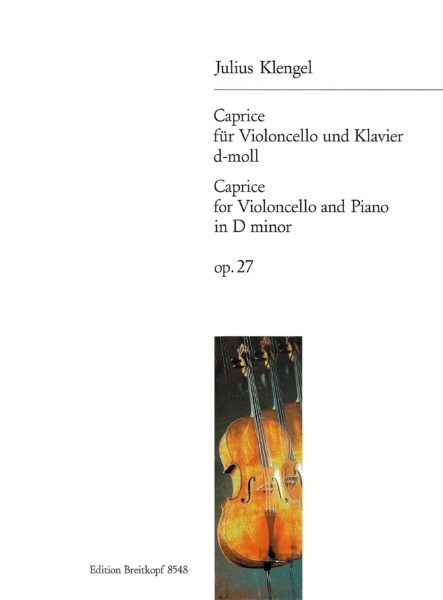Julius Klengel (1859–1933) Caprice d-moll op. 27
[Vc,Klav]
16 Seiten | 23 x 30,5 cm | 88 g | ISMN: 979-0-004-18131-7 | Broschur
Der Leipziger Cellist Julius Klengel (1859-1933) ist für sein Instrument mehr als ein halbes Jahrhundert intensiv tätig gewesen. Zum einen natürlich im Konzertsaal – seit seiner Aufnahme in das renommierte Leipziger Gewandhausorchester im Alter von 15 Jahren und spätestens seit seinem Debüt als Solist in der Saison 1880/81 im Leipziger Gewandhaus wirkte er zeitlebens als Interpret, dessen Kompetenz auch weit über seine Heimatstadt hinaus anerkannt wurde. Zum anderen als Komponist: der 21-jährige Klengel präsentierte sich dem Leipziger Publikum mit seinem eigenen Konzert a-moll op. 4 und schuf fortan, ohne in Vielschreiberei zu verfallen, regelmäßig Werke, die nur in Ausnahmefällen mit seinem Instrument nichts zu tun hatten. Ingesamt vier Solokonzerte, zwei Doppelkonzerte (eines davon mit Violine), zwei Streichquartette, mehrere Klaviertrios sowie in erster Linie eine Vielzahl von Solostücken und -studien für Violoncello mit und ohne Klavier finden sich in Klengels Werkkatalog. Den Besetzungen für mehrere Violoncelli, unter denen sich der Hymnus op. 57 für 12 Violoncelli (EB 6846/47) befindet, kommt dabei auch heute noch mehr als nur kuriose Bedeutung zu. Für alle Werke suchte und fand Klengel in Leipzig mit Breitkopf & Härtel ein großes, international tätiges Verlagshaus, das sämtliche seiner Kompositionen druckte und verbreitete.
Ohne einen Hinweis auf die pädagogischen Tätigkeiten jedoch ist seine Wirksamkeit noch nicht vollständig umrissen. Klengel unterrichtete parallel zu seiner praktischen und schöpferischen Arbeit als Lehrbeauftragter, später als Professor am Leipziger Konservatorium. Er komponierte Lehrwerke und Cellostudien. Darüber hinaus bearbeitete bzw. edierte er mit Blick auf die Verwendung im Unterricht etliche Cellowerke aus Barock, Klassik und Romantik – so u. a. die Bach-Suiten und Schumanns Cellokonzert.
Die Caprice d-moll op. 27 für Violoncello und Klavier steht ganz im Zeichen des virtuosen Interpreten, der sich seine Bravourwerke selbst komponieren konnte. Der Aufbau – eine A-B-A-B-A-Form – ist äußerst übersichtlich angelegt. Das Vivace (bzw. Vivacissimo im Schlussteil) macht dem Werktitel alle Ehre. Anders als bei vielen solistisch geprägten Stücken aus der zweiten Hälfte des 19. Jahrhunderts vergisst der Komponist den Begleiter keinesfalls. Auch das Klavier spielt eine dankbare Rolle und greift zuweilen regelrecht kontrapunktisch ins Geschehen ein. Verblüffend wirkt der von d-moll nach D-dur gewendete Schlussteil. Klengel forciert zwar, wie erwähnt, das Tempo zum Vivacissimo, er nimmt jedoch die Dynamik entschlossen zurück und hält diese 23 Takte fast konsequent im pianissimo sempre. Mit dem jeweils tiefsten, einsamen D der beiden Instrumente verlöscht das Stück.
Julius Klengels Caprice d-moll op. 27 für Violoncello und Klavier war lange Zeit vegriffen. Der Neuausgabe liegt der Erstdruck von 1891 zugrunde. Der Notentext wurde vor der Wiederveröffentlichung eingehend auf Unstimmigkeiten geprüft, Taktzähler wurden zur leichteren Orientierung ergänzt.
Frank Reinisch, Wiesbaden, Frühjahr 2002










 Blättern
Blättern